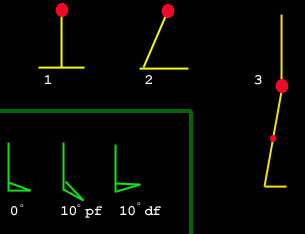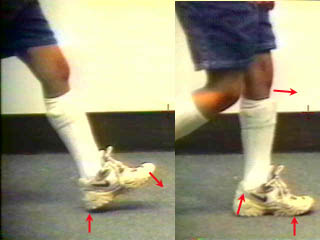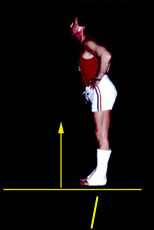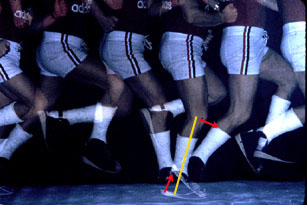 |
 First some terminology
First some terminology
1. Centralized support - a microphone stand. Obvious. Weight centered over base.
2. Eccentric support. Weight is still centered over base, but link isn't centered on base. It must converge on center as it reaches upwards to mass.
3. Has anybody noticed that the ankle joint is
NOT IN THE CENTER OF THE FOOT!!!!
Therefore there is nothing NEUTRAL about an ankle angle of zero degrees (first inset, in green). If your ankles are at zero degrees when you are standing, then you are not really standing so much as falling backward. Pointing the foot downward is called plantar flexion. Pointing the foot upward is called dorsiflexion. Above, we show ankle positions of 10 degrees plantar and 10 degrees dorsi flexion following the zero position. OK? Note that these measures are taken along the bottom of the foot relative to the shin (tibia). Hey, the people who first gave these terms a spin didn't have their [?] together. What can I say? We're stuck with this. The plantarflexed (tippy-toe) posture is also called equinus (like a horse).
Soooo, if the line we measure is just a bottom of the foot line not even passing through the ankle joint (it doesn't), then why not just use the bottom surface regardless? Even if it is the shoe sole?  Not only can you -- you should do that. The mechanics are simple. Three points. Knee center, heel contact, and forward rolling point. That forward rolling point is NOT the toe tips. It is the ball of
the foot (metatarsal heads). Notice that the bottom of the shoe may be a different angle than the bottom of the foot within because of the height of the shoe heels. Mechanically, the bottom plane of the shoe sole is what counts.
Not only can you -- you should do that. The mechanics are simple. Three points. Knee center, heel contact, and forward rolling point. That forward rolling point is NOT the toe tips. It is the ball of
the foot (metatarsal heads). Notice that the bottom of the shoe may be a different angle than the bottom of the foot within because of the height of the shoe heels. Mechanically, the bottom plane of the shoe sole is what counts.
After the foot rests flat on the ground, the ankle dorsiflexes (knee continues forward over the resting foot) until the shin-sole angle is about ten degrees. Then the ankle stiffens. That stiffening locks the ankle joint and forward momentum begins to roll on the forward rolling point. See above? Not the toe tip.
A very stiff shoe sole will impair metatarsal flexibility and cause the forward rolling point to be the toe tip. That long leverage out front with the ankle stiffened puts the brakes on. That won't roll. It will freeze the knee to an abrupt halt and the heel will either jump upward over a forward (toe) obstruction or just stay stuck in place.
Notice this. The normal ankle normally freezes up at dorsiflexion (shin-sole angle) of about 10 degrees. That is the functional relationship - not zero
degrees. Zero is nothing and certainly not right despite being a "right  angle" in drafting parlance.
angle" in drafting parlance.
If the ankle is made stiff by any means (tight muscles, screwed up joint surface, cast, orthosis, or misaligned prosthetic, and there is not built in functional dorsiflexion, then the body must do something to not fall backward. Jack knife posture in stance (as seen on the left) is USUALLY caused by this. In motion, it is a brief similar forward body lurch occurring at foot flat.
To cure the fellow on the left who can barely stand because he has casts set  in slight equinus (plantarflexion) we can add heel height to to the shoes to achieve 10 degrees of dorsiflexion (functional dorsiflexion, measured from shoe sole to shin). Wedges in
the shoe with a bit of cushion to soften the heel impact, get it near perfect and simulate normal foot ankle mechanics.
in slight equinus (plantarflexion) we can add heel height to to the shoes to achieve 10 degrees of dorsiflexion (functional dorsiflexion, measured from shoe sole to shin). Wedges in
the shoe with a bit of cushion to soften the heel impact, get it near perfect and simulate normal foot ankle mechanics.
With this alteration, he can run and jump hurdles, play basketball and kick butt. You DO NOT need ankle motion for running and sports etc. You need to get these relationships set properly.
In neuromuscular diseases, unremitting plantarflexion forces applied inside hinged orthoses will merely hold the orthosis fixed in the maximally plantarflexed position allowed by that particular device. Thus the stop point becomes a functionally fixed plantarflexion measure which makes the thing fail. Hinges are not hinges if what is within behaves unidirectionally. Some hyped up toe configuration which wraps the sides of the toe area or one too thick on the bottom or another just simply too stiff, will screw up forward roll by putting the brakes on. Kids get around those forward motion impediments by rotating the leg (in or out) to point the toe out of the way.
 What's the difference between a tight "Achilles"
and a cast set in some plantar flexion? Not much. Nor between those same geometries if found in an orthosis or set into a prosthesis. See?
What's the difference between a tight "Achilles"
and a cast set in some plantar flexion? Not much. Nor between those same geometries if found in an orthosis or set into a prosthesis. See?
Just three points. Knee center. Heel contact point, & forward rolling point.
Ignore all the mush in between those and you'll get it right. When it isn't right, we get repetitive stoppages. Bang bang bang bang bang bang bang bang.... eventually something has got to hurt. But what? What ever is the least able to deal. That varies. But notice, of the three points, two are very much related to the shoe.
Does this have anything to do with athletes - who do not wear braces nor casts? Yup. It does.
Soccer Shoes??
Ugggh. What's with the uggh? And what do you mean soccer? It's football! OK. OK. Everywhere except in the USA, soccer is called football. The problem is that there isn't a good second name for what is called football in the US. Maybe, it can be called BiGuWiCSOOGS (big guys with cleats stamping out other guys sensibilities). Or not. Either way, we're talking about SOCCER here and not BiGuWiCSOOGS. This naming isn't a problem, in any event, because you who live outside the U.S. don't need to know any of this and so the name 'soccer' won't confuse you as you quit reading right here. That's it. Stop. Go. Skedaddle. This ain't about you. You don't play soccer. You play football. This is about soccer.
They gone? Good.
OK, here's the deal, soccer players, what you play is a game - a sport. Everywhere else it isn't merely a sport, and definitely not a game, it is a religion. It is their main religion. They don't borrow playing fields from other sports. Most likely, they don't play other sports. They play, what they call football, all year round on religiously kept perfect surfaces that actually have grass ! (That green stuff you see on golf courses). Opulent grass. Really.
In the USA, soccer is played on whatever surface can be begged from whoever owns a field. Usually football or baseball, right? Even drag strips? And those surfaces are what? Yes. Hard clay with lots of little stones. Dried traces of dead grass might occasionally be found, but only as tokens. The only soft spots are where the white line lime got spilled.
And what do you wear on concrete-like dry clay studded with stones? Of course, cute little thin ballet slippers with spikes - uh huh - spikes designed for lush grass. Ballet slippers with spikes sounds unmanly to those of us accustomed to BiGuWiCSOOGS, and so we call them soccer "shoes". Shoes - wink wink.
So what's wrong with soccer slipp - er - shoes?
1) No heels.
2) The spikes up front are too plentiful and unsuited to stone hard clay and do not penetrate.
Daylight shines easily under the forefoot through the full running stride elevated by those
-bed of nails- spikes. The heel cluster does dig in, although the heel may well strike first
and ride over them.
Bottom line is that the forefoot is held elevated relative to the uncushioned heel and thus the need for dorsiflexion range is very severe as the tibia comes crashing forward. So, no cushion and high range at high velocity and a sudden jolt at the end of each step. Just run on toes? Yeah. On cement. Right.
Anyway, who's complaining? Ahhhh. Genetically dominant is the length of Achilles range. Some folks are a wee bit tighter than others. How tight, tends to run in families. Some families have many flat footed persons due to that , or even some with toe walkers from generation to generation. Put them in soccer shoes on hard ground and >> THEY << are the ones complaining.
Of what? Heel pain ( Sever's Syndrome ), or plantar fasciitis, or shin splints, or even knee aches and any of a whole bunch of achy things that merely tell you what is the
weakest link in the chain of parts getting repetitively jolted. The weakest link changes with age, so the
syndromes tend to cluster by age. When the heel growth plate is the most susceptible, it complains. When it closes, it isn't there to complain. Something else does. If there are high arches, then the forces on the
undersurface of the foot concentrate at the metatarsal heads. So, metatarsal head pain ( metatarsalgia ) gets on the list.
Interestingly, the Achilles mechanism, itself, is fairly insensitive and also very strong and so is the least likely thing to be hurting. How can you be sure the pain isn't - uh - The Plague? Wait a few days and if you are still around to generate that thought it isn't the plague. That was easy. But, how about rheumatism? Better question.
The main differential point is that MECHANICALLY induced pain syndromes link closely to mechanical cause, the rest do not.
So, if [whatever part] really aches when you play soccer but not when you don't, then think
tight Achilles + BAD SHOES
. Classic is this, "It hurts every season when I play soccer."
On the other foot, if pain has no apparent relationship to the game playing, just as likely to happen between seasons, think something else - Lyme disease, rheumatism or whatever lives in your neighborhood. There are two cures for the mechanical problem aside from just stopping until the pain goes away. That is, how to make it not come back.
Change you or change the shoes or both.
Change you. Stretch out the Achilles mechanism- note I didn't say tendon. Achilles stretch actually stretches the calf muscles . Tendon simply does NOT stretch despite all the hype you hear to the contrary. Tendon is very unlikely to stretch. It will rupture before it stretches. What you call stretching is really a growth cue. We are asking tissue to please grow longer. Pretty please. Please please please.
If it does respond, it will do so in the muscle units and make the overall functional length and thus the tendon seem longer. That means that we are not acutely stretching but rather biologically requesting length. The body does not respond well to abrupt, and pushy requests (that's where rupture comes from). Muscle units grow longer in response to SUSTAINED regular request. High force does not do it. Sustained daily gentle nudge does do it. Time stretches, not zeal.
Also there is a big difference between stretching exercises designed to not allow you to get muscle bound as a result of exercise and what is required to change an inborn biologic blueprint. Warm up exercises keep supple people supple. They WILL NOT MAKE INHERENTLY STIFF people supple.
Com'on, this is obvious. You just never thought about it this way. Do you honestly think that a few minutes warm up will make EVERYBODY limber? Everybody? All the same? Does that ever happen? No. So, some of you need to stretch loooooooooooong and between seasons and on getting out of bed, and after school, and before supper, and before hitting the sack at night and maybe even more.
There is a name for sustained Achilles stretch which is fun. It is called skiing. Really. Ski boots are great stretching tools.
Change the shoes? How about changing those ballet slippers - oops - those hairy chest manly soccer shoes? Dump'em. Gak. Ptuie. They stink. Period. Yeah yeah, I know, there are kinds of soccer shoes designed exactly for the surfaces I am describing. In fact, there are three main grades of soccer shoes. Has anybody ever seen them in actual stores? Not around here. They are like the great pumpkin. There is always some smart alek who can quote their existence. Theoretically, this fix is available out there. Practically, however, finding that fix can cost you the whole season getting it right. You'll love the blank look you'll get when you ask for those specialized soccer shoes in the sports store. Have your camera ready. Then do what? Rave at the shoe retailer for not stocking a rarely requested line of odd ball sport shoes in all available sizes and all three grades? Ok. That works for me. I like swatting windmills.
Or... go to the shoemaker. Ask him to help you buy (select) a pair of ordinary BASEBALL shoes, the soles of which can be easily converted by him to soccer specs. This is fast and reasonably cheap and works quite well - along with regular stretching. See? Running on a baseball field with baseball shoes! Wow. How cool is that?
This works for most folks. Still, a there are a few who will not get full relief with this. They typically have significant equinus (measured with the knee held in extension). If troublesome enough, a set of casts (worn in sneakers and allowing full activity - including soccer) will "stretch" the mechanism where exercise has failed. Why ? Round the clock stretch, even while sleeping. Time wins. We typically do this in the fall as it doesn't bugger summer swimming activities. It is like skiing but without the hot cocoa or lift tickets.